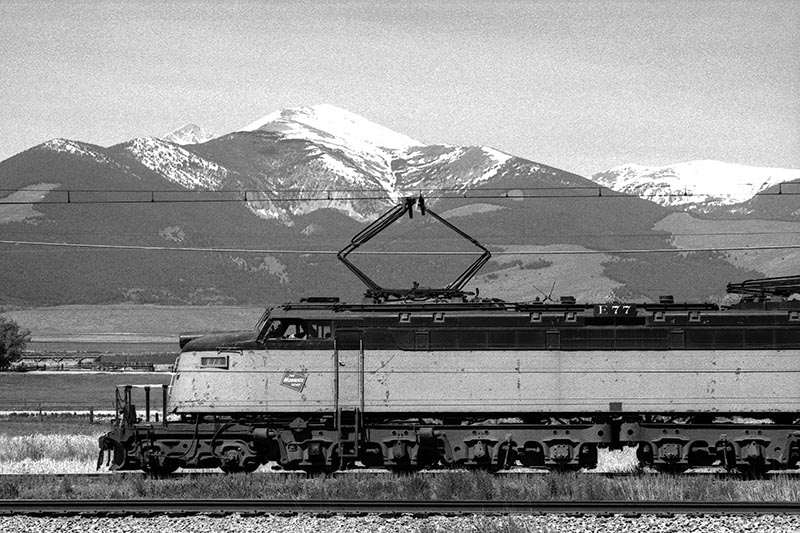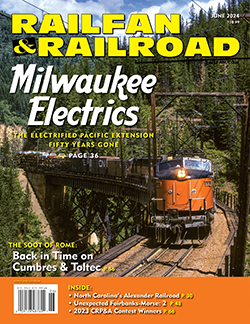 by Dick Dorn/photos by the author
by Dick Dorn/photos by the author
The Milwaukee Road had the distinction of building and operating the longest main line heavy electric railroad in the U.S. For more than 50 years, brutish electric locomotives hauled trains over five mountain passes in the Pacific Northwest on what was called the Pacific Extension. Starting in 1917, a variety of locomotives were utilized with General Electric being the dominant builder. This unique and often remote operation gained many fans over the years, and still does to this day, even though the wires were de-energized for good on June 15, 1974.
What would become the mighty Milwaukee Road began as Milwaukee & Mississippi Railroad on February 25, 1851, between Waukesha and Milwaukee, Wis., as the Badger State’s first railroad. As time progressed, the system grew through building new lines and acquiring other railroads. On February 11, 1874, the railroad took on a new name — Chicago, Milwaukee & St. Paul Railway — and by 1900 operated more than 6,000 miles of track. By all accounts, it was a prosperous Midwestern railroad well-positioned for growth.
At the same time, the Pacific Northwest was dominated by Union Pacific, Northern Pacific, and Great Northern, which all had lines reaching from the Midwest to the Pacific Coast. Milwaukee Road management decided that the railroad’s future was not secure with its dependence on bridge traffic from UP, NP, and GN; the only answer was to build its own line to the Pacific. Construction began in 1906 on a line from Mobridge, S.D., to Tacoma, Wash., a distance of 1,440 miles. The line would be shorter and hopefully faster than its three competitors. The Pacific Coast Extension was completed on May 14, 1909, without the use of any federal land grants. Purchasing rights-of-way across private land added considerable cost to the railroad. The original estimated construction cost was $45 million, though that was exceeded by more than $200 million when the cost of electrification was included. The railroad was soon renamed Chicago, Milwaukee, St. Paul & Pacific, reflecting its expanded transcontinental reach.
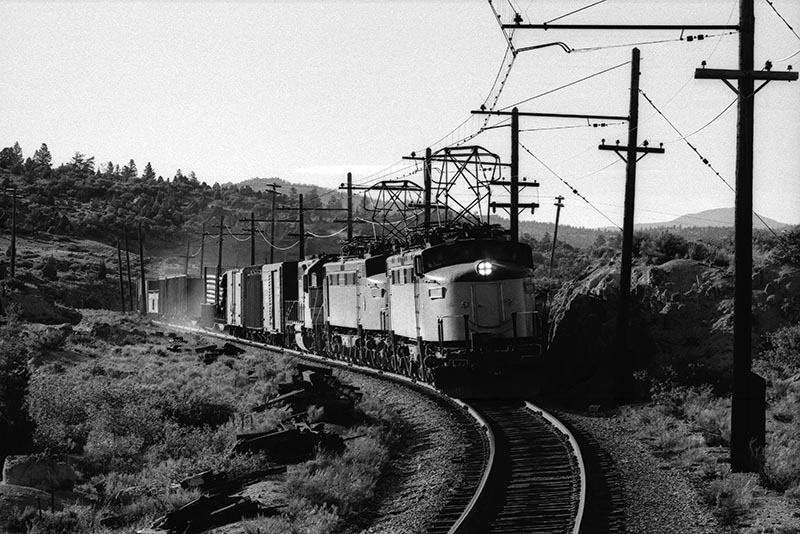
ABOVE: Train 264 with Joes E-72 and E-74 descends the 2 percent grade on the east side of Pipestone Pass on June 9, 1974. The Joes are in regenerative power mode and diesel 2058 is in full dynamic.
The extension began operations as a low-density single-track main line. There were short sections of both automatic and manual block signals, both with train orders instituted along with a “staff” system on a mountain-grade segment. Train orders were also used on the unsignaled “dark” territories, while upper-quadrant semaphores were installed elsewhere. In 1917 the railroad began upgrading parts of the automatic block signal (ABS) system with three-color signals. Within three decades it extended to more than 1,356 of the entire 1,440 miles, with train orders still used to dictate train movements.
As soon as the new extension opened for business, management began exploring the implementation of electric traction in the mountainous areas of Montana, Idaho, and Washington. Feasibility studies with General Electric began in 1913, and the following year, Milwaukee Road signed a contract for a package deal that included locomotives and the necessary infrastructure to operate the high-voltage d.c. electrification, including power distribution to the catenary and 14 substations. That year, construction began on the Rocky Mountain Division electrification from Harlowton, Mont., to Avery, Idaho, a total of 440 miles. Substations were located approximately every 35 miles in the flatter areas and 25 miles in the mountainous terrain. All construction was completed in 1917 at a cost of $12 million.
General Electric would provide 12 60-mph two-unit passenger locomotives and 30 two-unit 35-mph freight locomotives rated at 3,340 hp as part of the deal. Both were designed to operate under Milwaukee’s chosen 3,000-volt d.c. catenary system. These were the first-ever electric locomotives built using high-voltage d.c. regenerative braking. The advantage was that as the trains were going downgrade, they could use the regenerative braking to generate electricity to put back into the system while helping to maintain track speed.
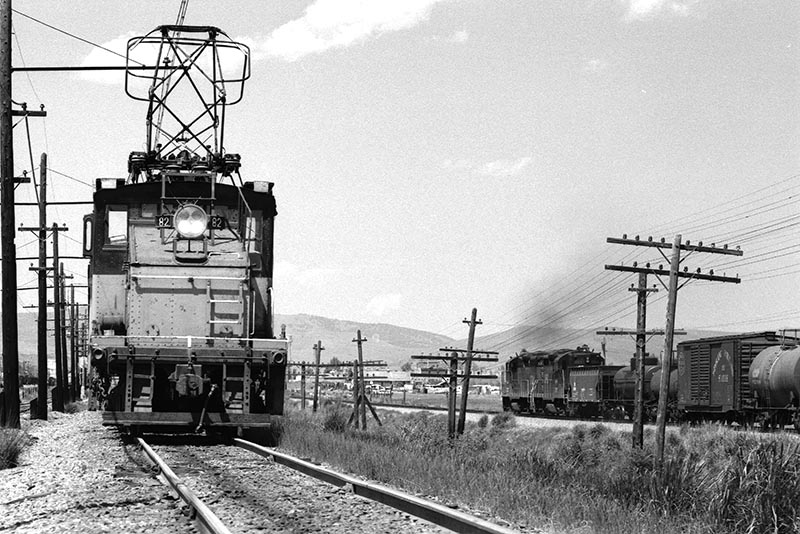
ABOVE: At the east end of the Deer Lodge yard, steeple cab E-82 switches as the westbound Burlington Northern local rumbles past heading for Missoula, Mont., with a pair of Geeps on the head end on June 14, 1974.
On September 25, 1915, the first locomotive (boxcab set 10200A-B) was delivered, billed as “the largest electric locomotive in the world.” To justify the cost of electrification, the railroad performed a test east out of Butte, Mont., up the 1.66 percent grade to the summit of Pipestone Pass. A 3,000-ton train with a two-unit boxcab on the point and a second boxcab as helper was able to maintain a constant 16 mph. A 2,000-ton steam freight followed with two 2-8-2s on the head end and a 2-6-6-2 helper; it was able to only make 9 mph up the hill. This demonstration sealed the deal for management as justification for its decision to electrify. Electrification was soon extended to include the Coast Division, covering 208 miles between Tacoma and Othello, Wash., with the installation completed in 1920.
With the electrification of both the Coast and Rocky Mountain divisions there were now 648 miles of main track under wires crossing both the Cascade and Rocky mountains. There were five mountain ranges that had to be conquered by electric-powered trains. On the Coast Division in Washington, there was the 22-mile climb up the Cascade Mountains from Cedar Falls to Hyak at Snoqualmie Pass. Next were the Saddle Mountains with a 10-mile climb from Kittitas up to Boylston on the west side, and the 18-mile climb from Beverly on the east side with a 2.2 percent grade — the railroad’s steepest. On the Rocky Mountain Division, mostly in Montana, the Bitterroot Mountains had a 22-mile climb out of Avery into Montana at East Portal on the west side and a 14-mile climb from Haugen to East Portal. Over on the Rocky Mountains, the west side climb from Butte to Pipestone Pass was 15 miles reaching an elevation of 6,347 feet, the highest point on the railroad; the opposite side featured a 21-mile ascent from Piedmont to the summit. The Belt Mountains had a gradual 48-mile climb from Lombard to Loweth on the west side and another 10-mile climb from Lennep to Loweth.
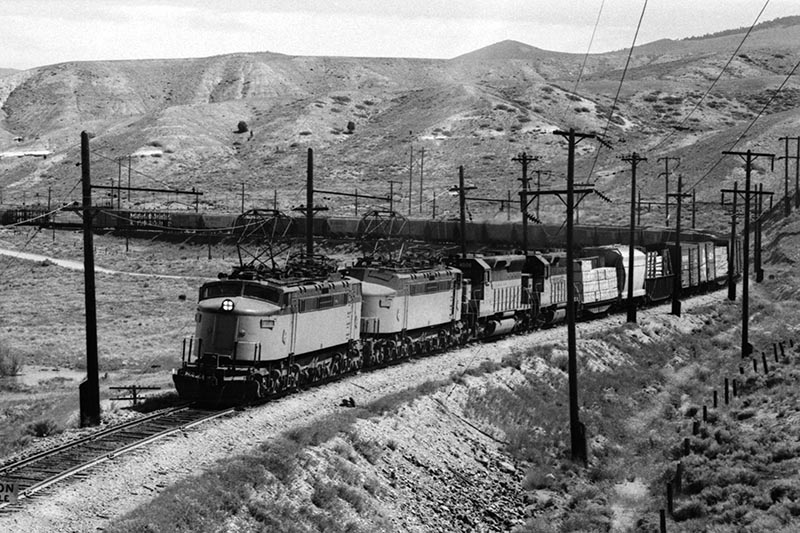
ABOVE: Eastbound Train 264 eases through the reverse curves at Morel on June 12, 1974. Joe E-71 and company have 51 cars on the headpin on this day.
Excepting the Belt Mountains, the other four passes normally required helpers. These passes are where the electrics really shined. They saved millions of dollars every year over conventional steam operation and required fewer locomotives to get the trains over the mountains. In addition, the electrics did not require frequent stops for water or fuel and required far less maintenance than steam locomotives. In the early 1930s, The Milwaukee Road concluded that it would be more advantageous to set up the boxcabs in sets of three units instead of two as they were running heavier trains, helping eliminate one train crew. Even heavier trains resulted in the development of four-unit box motor sets in 1951.
With the opening of the Coast Division electrification in 1920 there was an immediate need for more power. The Milwaukee Road decided to order additional passenger power in the form of 15 GE Bipolar units, but the U.S. Railroad Administration — briefly tasked with overseeing the nation’s railways during World War I — only allowed five and substituted 10 Westinghouse quill-drive units rated at 3,396 hp and a whopping 88 feet long. A single Westinghouse motor would be able to handle almost all passenger assignments, allowing the Milwaukee to re-gear the 12 passenger boxcabs for freight service. The units were loved by the train crews due to their power and smooth riding. They were not well-received by the maintenance departments, as they had constant issues and were hard on the track structure.
The GE bipolars were touted as the locomotives that would usher in electrification of main line railroading throughout the U.S. They were unique in that there were no gears in the trucks, and the armature was mounted on the axle. They were a rather handsome engine and well-liked by train crews and did not have the maintenance issues the quill motors had. At 3,180 hp, they were powerful enough for a single unit to handle almost all passenger trains but were not capable of working in multiple with another unit…


